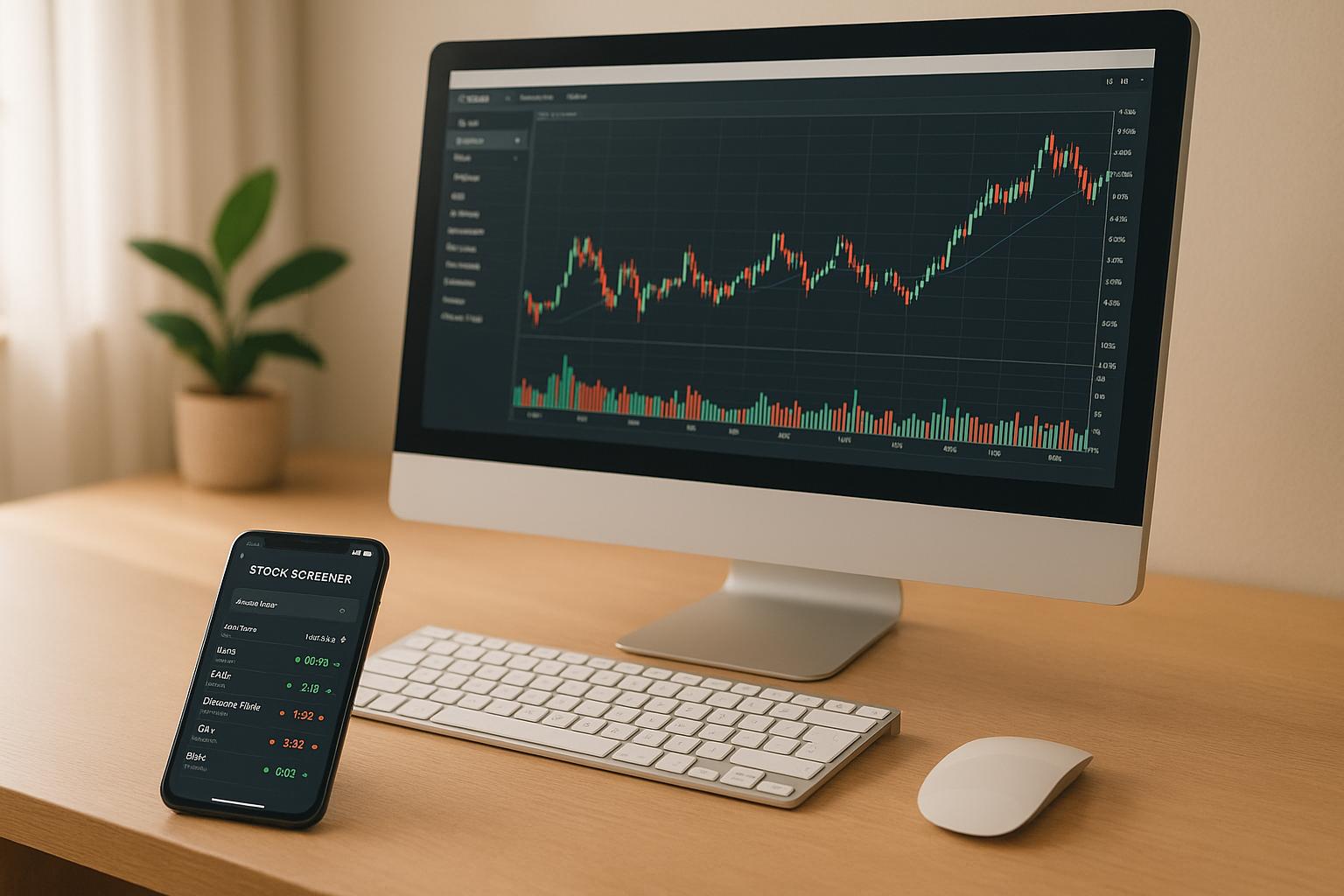Automated Fibonacci software simplifies technical analysis by identifying key price levels - such as 23.6%, 38.2%, 50%, 61.8%, and 78.6% - based on the Fibonacci sequence. These levels help traders anticipate potential support and resistance zones in financial markets. By automating this process, the software eliminates manual errors, saves time, and ensures consistent analysis across multiple timeframes.
Key Takeaways:
- How It Works: The software detects swing highs and lows in price trends, calculates retracement and extension levels, and overlays them on charts in real-time.
- Main Features:
- Auto-detection of swing points.
- Multi-timeframe analysis.
- Alerts for key price movements.
- Backtesting strategies using historical data.
- Customizable settings for ratios, colors, and visualizations.
- Benefits: Improves accuracy, reduces human error, and speeds up analysis.
- Limitations: May struggle in sideways markets, and algorithmic subjectivity in swing point selection can still occur.
This tool is best used alongside other indicators like RSI or MACD for a comprehensive trading strategy. While automation handles calculations, traders must still verify trends and market conditions for effective decision-making.
Automatic Fibonacci Retracement indicator for TradingView

Fibonacci Basics and Key Ratios
The foundation of Fibonacci analysis is rooted in a straightforward mathematical sequence. By understanding these principles, it becomes easier to see how automated tools pinpoint critical price levels in trading. This mathematical groundwork explains the ratios that traders rely on.
The Fibonacci Sequence and Ratios
The Fibonacci sequence is a series of numbers where each number is the sum of the two preceding ones, beginning with 0 and 1. This generates the pattern: 0, 1, 1, 2, 3, 5, 8, 13, 21, 34, 55, 89, 144, and so on. Leonardo of Pisa, also known as Fibonacci, introduced this sequence to Western mathematics in his 1202 book Liber Abaci. However, the sequence had already been recognized in India much earlier.
Key trading ratios are derived from relationships within this sequence. For example:
- Dividing a Fibonacci number by the next one approaches 0.618.
- Dividing a Fibonacci number by the previous one approaches 1.618, known as the golden ratio.
These calculations form the basis of the primary Fibonacci ratios used in trading:
- 23.6% – Found by dividing a number by the one three places ahead.
- 38.2% – Derived from dividing a number by the one two places ahead.
- 50% – While not a true Fibonacci ratio, it’s widely used in trading, influenced by Dow Theory.
- 61.8% – The golden ratio, often seen as the most crucial level.
- 78.6% – An additional retracement level used by traders.
The golden ratio itself, approximately 1.618033988749895, was formally defined by Euclid around 300 B.C.. These ratios are the backbone of how traders map price movements on charts.
How Fibonacci Levels Apply to Price Charts
Automated Fibonacci software uses these ratios to overlay support and resistance levels directly onto price charts. These calculations help identify zones where prices might pivot.
In an uptrend, Fibonacci levels often signal where prices may temporarily pull back before continuing higher. Key retracement levels like 38.2%, 50%, and 61.8% often act as potential buying zones. Conversely, in a downtrend, these same levels serve as resistance points where selling pressure might resume after a brief rally.
The 61.8% level stands out due to its direct connection to the golden ratio. Automated trading systems continuously monitor these levels, alerting traders when prices approach these mathematically significant zones.
The effectiveness of Fibonacci levels largely comes from their widespread use among traders. When many participants focus on the same 61.8% retracement level, their collective actions often lead to price reactions at these points. Automated tools excel in identifying these levels quickly and consistently, outperforming manual analysis in speed and precision.
What sets Fibonacci ratios apart is their objectivity. Unlike other technical analysis methods that can be subjective, Fibonacci calculations yield the same results no matter who performs them. This consistency makes automation a reliable tool in various market conditions.
How Automated Fibonacci Software Works
Automated Fibonacci software uses advanced algorithms to remove the guesswork from technical analysis. These systems constantly analyze price data, pinpoint key turning points, and compute retracement levels with precision. What once required meticulous manual effort now happens instantly and objectively.
Identifying Highs and Lows in Price Movements
The core of automated Fibonacci analysis lies in detecting swing highs and swing lows in price trends. Swing highs are local peaks where prices face resistance and reverse downward, while swing lows are local troughs where prices find support and rebound upward.
Automated tools identify these critical points by analyzing price data over a specified lookback period. They scan recent price movements to locate key swing points, which then serve as the basis for calculating Fibonacci retracement and extension levels. This process is ongoing, updating in real time as new market data emerges, ensuring that Fibonacci levels stay aligned with current price trends.
These tools are particularly effective at handling large datasets, often analyzing multiple timeframes simultaneously. This capability minimizes the risk of overlooking subtle yet impactful price shifts.
Algorithm Precision and Customization Features
Once swing points are identified, advanced algorithms calculate retracement levels with mathematical accuracy. These systems determine the most relevant Fibonacci levels for each timeframe, removing the subjectivity that often affects manual analysis.
The software calculates retracement levels - such as 23.6%, 38.2%, 50%, 61.8%, and 78.6% - by dividing the distance between swing highs and lows. Similarly, extension levels like 1.618 and 2.618 are derived using established mathematical principles.
Many platforms allow users to customize settings to align with their trading preferences. For example, traders can modify the lookback period to emphasize recent price action or broaden the analysis to include longer-term trends. Some advanced systems even create zones around Fibonacci levels instead of single lines, addressing the inherent subjectivity in marking precise levels on charts.
The 61.8% level, often called the "golden ratio", is particularly emphasized in automated systems due to its mathematical importance and its frequent association with potential price reversals. This level, along with others, is calculated with precision, making the analysis both faster and more reliable.
Eliminating Human Error in Analysis
One of the major benefits of automated Fibonacci tools is their ability to reduce human error and emotional bias - two common pitfalls in technical analysis. Manual Fibonacci analysis requires traders to subjectively pick swing highs and lows, which can lead to inconsistent results or missed opportunities. Automated systems, on the other hand, apply consistent mathematical rules, removing this variability.
By plotting Fibonacci levels with precision, these tools enable traders to act quickly on market opportunities without delays caused by manual calculations. This speed is especially valuable in fast-paced markets where timing is critical.
Automation also brings consistency. Traders often highlight the reliability of automated Fibonacci systems, as they save time on repetitive calculations and significantly reduce the chances of human error. This consistency allows traders to focus on strategy rather than worrying about the accuracy of their analysis.
sbb-itb-2e26d5a
Main Features and Setup Options
Modern Fibonacci analysis software has come a long way, offering a range of features and flexible setup options that make it easier for traders to fine-tune their strategies. These tools now go well beyond basic retracement calculations, providing advanced functionalities that cater to different market conditions and skill levels.
Standard Features of Fibonacci Tools
One of the standout features is auto-detection of swing points, which takes the guesswork out of identifying key price movements. This automation reduces manual errors and ensures a consistent, objective approach to analysis.
Another key feature is multi-timeframe analysis (MTFA). This allows traders to overlay Fibonacci retracements from multiple timeframes on a single chart. For example, you can simultaneously view retracement levels from daily and hourly charts, helping you spot where support or resistance levels from different timeframes might align.
Alert systems are another valuable tool, sending real-time notifications when prices break through, touch, or bounce off specific Fibonacci levels. This ensures you won’t miss critical price movements, even if you’re not actively monitoring the charts.
For those who like to test their strategies before committing real money, backtesting capabilities are essential. They allow traders to evaluate the effectiveness of their approach using historical data, offering a statistical foundation for decision-making.
Advanced platforms like MotiveWave take it a step further by offering a full suite of Fibonacci tools - such as retracement, extension, and expansion tools - with customizable ratios and levels. These platforms often integrate with popular charting software, making it easier to incorporate Fibonacci analysis into your existing workflow.
Setup Options for Personal Analysis
Customization options give traders the ability to tailor their analysis to fit their unique trading strategies. For example, color and visual customization tools let users adjust the appearance of Fibonacci levels, including stroke, color, and visibility. This is particularly helpful when working with charts that already include multiple technical indicators.
Platforms like TrendSpider offer analysis type settings, such as "Original" and "Enhanced" modes. The Enhanced mode focuses on larger price swings, while the Original mode captures smaller movements, allowing traders to adjust sensitivity based on their strategy.
When it comes to plotting Fibonacci levels, traders can choose between swing point calculation methods like "Body to Body" (using opening and closing prices) or "Wick to Wick" (capturing the full price range). Each method provides a slightly different perspective on trendlines and Fibonacci levels.
For experienced traders, custom ratio adjustments offer even more flexibility. While traditional Fibonacci levels like 23.6%, 38.2%, 50%, 61.8%, and 78.6% are widely used, some traders prefer to add levels like 88.6% or remove others that don’t align with their strategy.
TrendSpider also includes a Truth in Analysis Line feature, which marks the exact timestamp when the Fibonacci analysis was performed. This helps traders know when it’s time to refresh their calculations to reflect the latest price movements.
Finally, risk management integration allows for automated stop-loss and take-profit settings based on Fibonacci levels. This feature not only streamlines trade execution but also supports disciplined risk management by reducing the time between analysis and action.
Pros and Cons of Automated Fibonacci Analysis
Automated Fibonacci software brings both advantages and challenges to the table. Being aware of these can help traders make informed decisions about incorporating automation into their technical analysis toolkit.
Benefits of Automation
One of the standout advantages of automation is how much time it saves. As highlighted by Trade View Tech:
Automating the process of identifying potential entry and exit points saves time and refocuses traders on strategy.
Instead of manually plotting Fibonacci levels on every chart, automation allows traders to quickly generate retracements and extensions across their entire watchlist. This not only speeds up the process but also ensures a consistent approach, reducing the chance of impulsive decisions.
Another key benefit is the improved accuracy that automation provides. By minimizing human errors - like choosing incorrect swing points - automated tools ensure Fibonacci levels are applied more precisely. For example, TrendSpider’s software automatically identifies high and low points for plotting, addressing common issues with manual analysis.
Additionally, many automated Fibonacci tools come with backtesting capabilities, providing traders with the ability to test strategies against historical data. This helps differentiate between methods that work consistently and those that are only effective under specific conditions. It also ties into the broader discussion about the precision and flexibility of algorithmic setups.
With automated trading accounting for about 60–73% of U.S. equity trading volume, leveraging automated Fibonacci analysis enables individual traders to stay competitive in a market increasingly driven by algorithms.
Drawbacks of Automation
Despite its benefits, automated Fibonacci analysis has its share of limitations. One common issue is subjectivity in swing point selection. Even with consistent algorithms, traders may choose different swing points, leading to conflicting Fibonacci levels.
Another challenge is market condition dependency. Fibonacci levels often lose reliability in choppy or sideways markets, where price movements don’t follow clear trends.
The risk of false signals is also a concern. Prices may breach Fibonacci levels without reversing, creating ambiguous signals if the broader market context isn’t considered.
Algorithmic limitations present another hurdle. For example, fully automating grid-building within expert advisor (EA) code is still not feasible. Traders often need to step in to confirm trend starting points and validate signals.
Lastly, some argue that Fibonacci levels can act as a self-fulfilling prophecy. Because so many traders rely on them, collective actions might influence price behavior, potentially reducing the effectiveness of the analysis over time. Combining Fibonacci tools with broader market insights can help mitigate this issue.
Comparison Table: Pros and Cons
Here’s a quick breakdown of the advantages and limitations of automated Fibonacci analysis:
| Aspect | Advantages | Limitations |
|---|---|---|
| Speed & Efficiency | Quick calculations across multiple timeframes | - |
| Accuracy | Reduces human error in calculations | Subjective swing point selection can still cause issues |
| Consistency | Encourages a systematic, emotion-free approach | May fail to account for broader market dynamics |
| Backtesting | Validates strategies using historical data | Past performance doesn’t guarantee future success |
| Risk Management | Automates stop-loss and take-profit orders | Can generate false signals, leading to unnecessary trades |
| Market Adaptability | Works well in trending markets | Struggles in sideways or choppy market conditions |
Conclusion and Key Takeaways
Automated Fibonacci software simplifies technical analysis by pinpointing retracement levels - 23.6%, 38.2%, 50%, 61.8%, and 78.6% - with precision, eliminating the risk of manual plotting errors. This allows traders to shift their focus to crafting and refining trading strategies.
In fast-paced markets, automation becomes a game-changer by identifying entry and exit points quickly. This speed is critical, as timely decisions often determine whether a trade results in profit or loss.
However, automation alone isn’t enough. A disciplined trading approach is vital. Combining automated Fibonacci tools with additional technical indicators like moving averages, RSI, or MACD often leads to more robust strategies.
Risk management also plays a key role. For instance, traders often place stop-loss orders just beyond Fibonacci levels and adjust position sizes to manage exposure. A case in point: In February 2024, Palo Alto Networks (PANW) experienced a sharp decline. Traders spotted potential reversal opportunities near the 61.8% retracement level at $318 and placed stop-loss orders below the 76.4% level to mitigate risk.
Backtesting further strengthens strategies by distinguishing consistently reliable approaches from those that only succeed under specific conditions.
To make the most of these tools, traders must balance automation with active involvement. While the software handles calculations, successful trading requires confirming trends, carefully selecting swing points, and looking for alignment with other technical signals. This combination of automated precision and human oversight is essential for consistent profitability.
For detailed reviews of automated Fibonacci software and other technical analysis tools, explore the Best Investing Tools Directory at https://bestinvestingtools.com.
FAQs
How do automated Fibonacci tools make trading more accurate than manual analysis?
Automated Fibonacci tools take the guesswork out of trading by reducing human error and delivering consistent results. These tools can swiftly identify crucial levels such as support, resistance, and price targets, giving traders a clearer picture to base their decisions on.
They also enable multi-timeframe analysis and provide objective measurements, helping traders stay focused and avoid emotional or biased decisions. By simplifying calculations and offering accurate data, automated Fibonacci tools play a key role in boosting trading accuracy and improving decision-making.
Can automated Fibonacci software work effectively in all market conditions, or does it perform better in specific scenarios?
Automated Fibonacci software works best in trending markets, where it can effectively identify critical support and resistance levels during clear upward or downward price movements. When market trends are well-defined, these tools can help traders pinpoint potential entry and exit points with improved precision.
On the flip side, in sideways or highly volatile markets, the software's reliability can decrease. Erratic price movements in such conditions often result in false signals. To achieve more consistent insights, many traders opt to apply Fibonacci tools to longer time frames, such as 1-hour charts or higher, as these tend to offer steadier and more actionable data in trending scenarios.
What customization options does automated Fibonacci software offer for different trading strategies?
Automated Fibonacci software offers a range of customization options designed to fit different trading strategies. Traders can tweak Fibonacci levels, change color schemes for better clarity, and define specific high and low points for calculations. The software also lets users toggle tools like retracements, extensions, and arcs, enabling them to focus on the features they find most useful.
These options give traders the flexibility to adjust the software to match their individual preferences and trading styles. By fine-tuning these settings, they can improve their technical analysis and make smarter market decisions.


